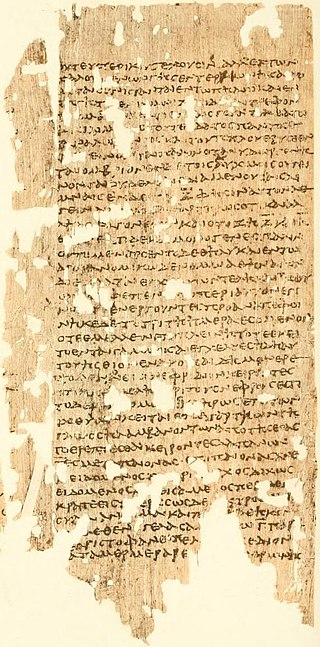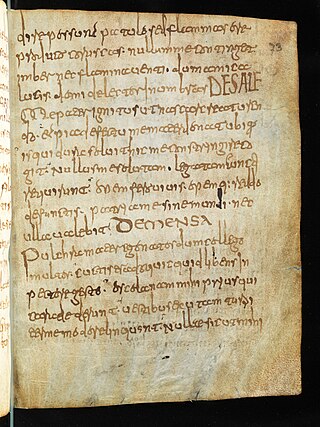Related Research Articles

Esus is a Celtic god known from iconographic, epigraphic, and literary sources.

In Celtic mythology, Taranis is the god of thunder, who was worshipped primarily in Gaul and Hispania but also in the Rhineland and Danube regions, amongst others. Taranis, along with Esus and Teutates, was mentioned by the Roman poet Lucan in his epic poem Pharsalia as a Celtic deity to whom human sacrificial offerings were made. Taranis was associated, as was the Cyclops Brontes ("thunder") in Greek mythology, with the wheel.

Nicander of Colophon was a Greek poet, physician, and grammarian. He was born at Claros, near Colophon, where his family held the hereditary priesthood of Apollo. He flourished under Attalus III of Pergamum.

Aulus Persius Flaccus was a Roman poet and satirist of Etruscan origin. In his works, poems and satire, he shows a Stoic wisdom and a strong criticism for what he considered to be the stylistic abuses of his poetic contemporaries. His works, which became very popular in the Middle Ages, were published after his death by his friend and mentor, the Stoic philosopher Lucius Annaeus Cornutus.

Demogorgon is a deity or demon associated with the underworld. Although often ascribed to Greek mythology, the name probably arises from an unknown copyist's misreading of a commentary by a fourth-century scholar, Lactantius Placidus. The concept itself can be traced back to the original misread term demiurge.

A wicker man was purportedly a large wicker statue in which the druids sacrificed humans and animals by burning. The primary evidence for this practice is a sentence by Roman general Julius Caesar in his Commentary on the Gallic War, which modern scholarship has linked to an earlier Greek writer, Posidonius.
Scholia are grammatical, critical, or explanatory comments – original or copied from prior commentaries – which are inserted in the margin of the manuscript of ancient authors, as glosses. One who writes scholia is a scholiast. The earliest attested use of the word dates to the 1st century BC.

De Bello Civili, more commonly referred to as the Pharsalia, is a Roman epic poem written by the poet Lucan, detailing the civil war between Julius Caesar and the forces of the Roman Senate led by Pompey the Great. The poem's title is a reference to the Battle of Pharsalus, which occurred in 48 BC, near Pharsalus, Thessaly, in Northern Greece. Caesar decisively defeated Pompey in this battle, which occupies all of the epic's seventh book. In the early twentieth century, translator J. D. Duff, while arguing that "no reasonable judgment can rank Lucan among the world's great epic poets", notes that the work is notable for Lucan's decision to eschew divine intervention and downplay supernatural occurrences in the events of the story. Scholarly estimation of Lucan's poem and poetry has since changed, as explained by commentator Philip Hardie in 2013: "In recent decades, it has undergone a thorough critical re-evaluation, to re-emerge as a major expression of Neronian politics and aesthetics, a poem whose studied artifice enacts a complex relationship between poetic fantasy and historical reality."

Homeric scholarship is the study of any Homeric topic, especially the two large surviving epics, the Iliad and Odyssey. It is currently part of the academic discipline of classical studies. The subject is one of the oldest in education.

Venetus A is the more common name for the 10th-century AD manuscript codex catalogued in the Biblioteca Marciana in Venice as Codex Marcianus Graecus 454, now 822. Its name is Latin for "Venetian A."
Vacca was a 6th-century grammarian who studied and commented on the works of Lucan. Little is known of Vacca other than that he wrote Vita Lucani, which is not to be confused with Suetonius' Vita Lucani.

Teutates is a Celtic god attested in literary and epigraphic sources. His name, derived from a proto-Celtic word meaning "tribe", suggests he was a tribal deity.

The gods and goddesses of the pre-Christian Celtic peoples are known from a variety of sources, including ancient places of worship, statues, engravings, cult objects, and place or personal names. The ancient Celts appear to have had a pantheon of deities comparable to others in Indo-European religion, each linked to aspects of life and the natural world. Epona was an exception and retained without association with any Roman deity. By a process of syncretism, after the Roman conquest of Celtic areas, most of these became associated with their Roman equivalents, and their worship continued until Christianization. Pre-Roman Celtic art produced few images of deities, and these are hard to identify, lacking inscriptions, but in the post-conquest period many more images were made, some with inscriptions naming the deity. Most of the specific information we have therefore comes from Latin writers and the archaeology of the post-conquest period. More tentatively, links can be made between ancient Celtic deities and figures in early medieval Irish and Welsh literature, although all these works were produced well after Christianization.
The threefold death, which is suffered by kings, heroes, and gods, is a reconstructed Proto-Indo-European theme encountered in Indic, Greek, Celtic, and Germanic mythology.

The Burgerbibliothek of Berne is a public library located at Münstergasse 63 in Bern, Switzerland.

The Vacomagi were a people of ancient Scotland, known only from a single mention of them by the geographer Claudius Ptolemy. Their principal places are known from Ptolemy's map c.150 of Albion island of Britannia – from the First Map of Europe.
Junius Philargyrius was an early commentator on the Bucolica and Georgica of Vergil, dedicated to a certain Valentinianus. He was a member of the Junia gens, active in Milan.

Papyrus Oxyrhynchus 221 contains Homeric scholia by an unknown author, written in Greek. It was discovered in Oxyrhynchus, Egypt. The manuscript was written on papyrus in the form of a roll. It is dated to the second century. Frederic G. Kenyon dated it to the first century or the first half of the second century. Currently it is housed in the British Library in London.

The Bern Riddles, also known as Aenigmata Bernensia, Aenigmata Hexasticha or Riddles of Tullius, are a collection of 64 rhythmic Latin riddles, named after the location of their earliest surviving manuscript, which today is held in Bern : the early eighth-century Codex Bernensis 611.

The Lyon cup is a silver Gallo-Roman cup found in Lyon, France.